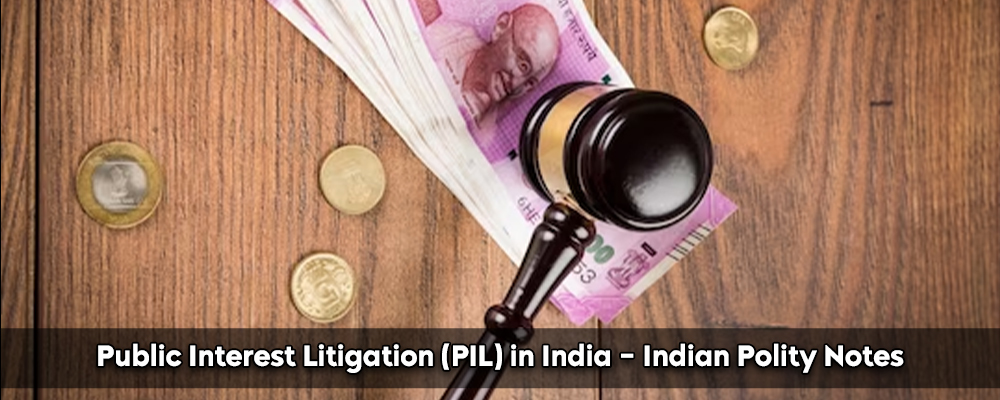A Public Interest Litigation also known as PIL is filed to ensure or enforce matters related to public interest. Public Interest could be understood as the interest belonging to a particular class of the community affecting their legal rights or liabilities. It may also include pecuniary interest.
What is a PIL?
A PIL has not been defined under any Indian statute. It shall be filed before the courts under the Constitution of India in order to protect public rights as well as promote general welfare. The concept of PIL in India, started from the power of judicial review. A PIL could be filed in the court of law not only by the aggrieved person but by a private person who is interested in public welfare and betterment of society as well.
A PIL could be filed for any matter which affects the interest of the public, such as road safety, pollution, construction hazards, neglection of children, terrorism,, atrocities committed on women, exploitation of the workers, bonded labour, non-payment of minimum wages, matters related to food adulteration, disturbance in the ecological balance, maintenance of heritage and culture, etc.
Need A Legal Advice
The internet is not a lawyer and neither are you. Talk to a real lawyer about your legal issue

Who can file a PIL?
A Public Interest Litigation could be filed by any individual or organisation in order to protect or enforce a right owed to him or her by the Constitution or even by a section of the society who has been disadvantaged or oppressed or is not able to enforce their own rights.
The concept of “Locus Standi” has been relaxed for the PILs in order to enable the Hon’ble Court to look into the grievances filed on behalf of those who are poor, illiterate, deprived or disabled or any other such party which is unable to approach the courts themselves.
A person acting in good faith and has sufficient interest in the proceedings only would have locus standi to file a PIL. Any person approaching the Hon’ble Court for personal gain, political or any oblique consideration shall not be entertained.
The Court of Law may also take suo moto cognizance.
Where can a PIL be filed?
PILs could be understood as the extensions of Writ Jurisdiction. Therefore, PILs can be filed either before the Hon’ble Supreme Court of India as provided under Article 32 of the Indian Constitution or any High Court under Article 226 of the Indian Constitution.
Also, even a simple letter or a postcard addressed to the Chief Justice of India or the Chief Justice of a High Court may suffice. The court, then may choose to take cognizance of the letter, converting it into a PIL as in the case of Rural Litigation & Entitlement Kendra, Dehradun vs. State of Uttar Pradesh [(AIR 1989 SC 594)], where the Court accepted a letter raising the issue of unauthorised and illegal mining in Mussoorie Hills as a writ petition under the Public Interest Litigation.
Examples of the Public Interest Litigation cases
PILs play an important role in India’s polity, responsible for a few landmark judgements in India, such as banning the triple talaq, opening doors of the Sabarimala and the Haji Ali shrines for women, legalising consensual homosexual relationships, legalising passive euthanasia, etc.
Some of the examples of PIL are as follows:
Hussainara Khatoon vs. State of Bihar case
was the first reported instance of PIL in India, having brought attention to the issue of inhuman conditions of prisoners and undertrial prisoners.
Vishaka vs. State of Rajasthan
the issue of sexual harassment in the workplace was raised in this case. As a result of which, the Vishaka Guidelines came into effect, which were published in 1997, which provided employers with the definition of sexual harassment, a list of preventative strategies for the same, as well as information on filing complaints of workplace sexual harassment.
M.C. Mehta vs. Union of India
was filed for the matter of pollution in the Ganges basin. Directions were given in the judgement to prevent the consequences of water and air pollution on millions of people living in the Ganga basin, as well as emphasised the need for sustainable development.
Javed vs. State of Haryana
the constitutionality of a population control provision related to the panchayat election was challenged. According to the Haryana Provision, which disqualified persons having more than two children from holding certain offices in the panchayats. The court emphasised the problem of population explosion as a global and national issue at the expense of protecting human rights. It was held that the said Provision was well-defined and was based on a clear objective to popularise the matter of family planning.
Conclusion
A Public Interest Litigation ensures that the public bodies are held accountable by acting reasonably within the limits of their powers and ensure they make precise choices. It also expands the scope of law by helping the judges understand the legislation and develop laws further. It also provides weak people a voice by emphasising a significant issue and offers them a platform to advocate their rights. A PIL also helps raise awareness of critical public problems through media coverage as well as debates.
In case you wish to understand the subject further, it is advised that you seek further advice from an experienced advocate. Lead India offers you a team of experienced lawyers who have been successfully handling cases related to various matters related to civil as well as criminal laws. Thus, if you wish to talk to a lawyer about filing a PIL or seek free legal advice online, you may contact us.





 Talk to a Lawyer
Talk to a Lawyer